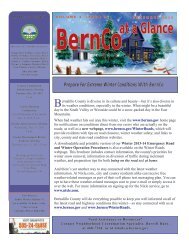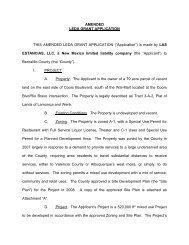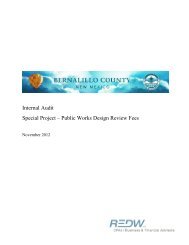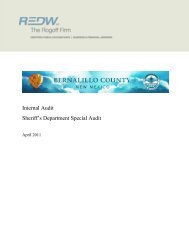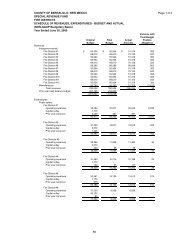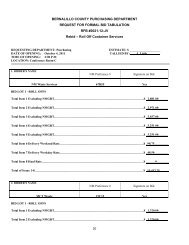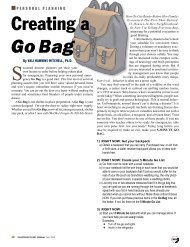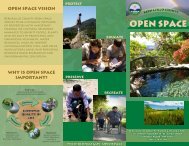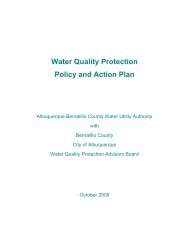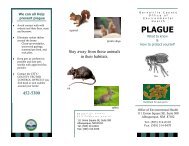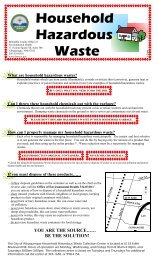East Mountain Trails & Bikeways Master Plan - Bernalillo County
East Mountain Trails & Bikeways Master Plan - Bernalillo County
East Mountain Trails & Bikeways Master Plan - Bernalillo County
You also want an ePaper? Increase the reach of your titles
YUMPU automatically turns print PDFs into web optimized ePapers that Google loves.
Section B. Guidelines for Trail and<br />
Bikeway Facility Types<br />
Many roads in the <strong>East</strong> <strong>Mountain</strong> Area began as<br />
trails, prior to the development of motorized<br />
travel and local, state and federal road systems.<br />
These roads continue to be critical for nonmotorized,<br />
as well as motorized travel, both for<br />
local connections and for regional transportation.<br />
All new projects or major reconstruction projects<br />
shall accommodate travel by pedestrians and<br />
bicyclists, except where pedestrians and<br />
bicyclists are prohibited by law from using a<br />
given facility or where the costs of including<br />
bikeways and walkways would be excessively<br />
disproportionate to the need or probable use.<br />
Where potential trails are near acequias,<br />
coordination with the Acequia Association is<br />
required. Equestrians will be accommodated in<br />
those corridors where there is current or<br />
projected equestrian use and where sufficient<br />
separation from vehicular traffic can be achieved.<br />
Facilities for pedestrian, bicycle and equestrian<br />
use shall be designed to the best currently<br />
available standards and guidelines, such as<br />
AASHTO's Guide for the Development of Bicycle<br />
Facilities (1999) and Guide for the <strong>Plan</strong>ning,<br />
Design, and operation of Pedestrian Facilities<br />
(2004) and the Manual for Uniform Traffic Control<br />
Devices (MUTCD) for signing and marking of<br />
road crossings, bikeways, walkways and<br />
equestrian trails.<br />
In the rural <strong>East</strong> <strong>Mountain</strong> Area of <strong>Bernalillo</strong><br />
<strong>County</strong>, appropriate accommodations may range<br />
from shared roads or shoulders to sidewalks<br />
and/or separate multi-use trails, either paved or<br />
soft surface. Major bike corridors will be<br />
designated with Bike Route signs.<br />
The Americans with Disabilities Act of 1990<br />
(ADA), a federal law prohibiting discrimination<br />
against people with disabilities, requires public<br />
entities to provide accessible accommodations<br />
for people with disabilities. Regulations provide<br />
that when new pedestrian facilities (or projects<br />
that alter existing facilities) are planned, those<br />
facilities must be designed and constructed to be<br />
accessible to and usable by people with<br />
disabilities. Trail design criteria are provided in<br />
the U.S. Access Board draft Guidelines for<br />
Outdoor Developed Areas. Draft guidelines for<br />
public rights-of-way can be found in the U.S.<br />
Access Board Accessible Rights-of-Way: a<br />
Design Guide (1999).<br />
The following cross-sections (page 45-48)<br />
illustrate the critical dimensions and relationships<br />
between various types of accommodations. The<br />
combination of facilities and users will vary for<br />
individual road and trail corridors and subsequent<br />
design will be tailored for each section.<br />
1. Rural Roads<br />
Many existing rural roads with low traffic volumes<br />
and speeds serve motorized vehicles, bicyclists,<br />
pedestrians and equestrians well, either within<br />
the travel lane or on shoulders. Shoulder width<br />
and treatment become more important as traffic<br />
volumes and speeds increase and in areas with<br />
steep grades or where visibility is limited.<br />
• Narrow, low speed, dirt or gravel roads, with low<br />
volumes and good sight distances can accommodate<br />
non-motorized users with few improvements.<br />
• Paved locals - Though not ideal, if less than 1000<br />
Average Daily Traffic, paved locals with slow speeds<br />
and good sight distances may accommodate<br />
bicyclists and pedestrians even with shoulders less<br />
than 4'.<br />
• If existing paved roads are too narrow to<br />
accommodate other users safely and existing right of<br />
way isn’t adequate to provide safe accommodations,<br />
acquisition of additional right of way is recommended.<br />
For new development, adequate right of way will be<br />
secured at time of development to accommodate<br />
future bicycle and pedestrian facilities.<br />
• Issues: As more roads are paved to reduce<br />
"fugitive dust" and comply with Air Quality<br />
regulations, or at the request of residents,<br />
special provisions for non-motorized travelers<br />
Page 46<br />
EAST MOUNTAIN TRAILS AND BIKEWAYS MASTER PLAN



